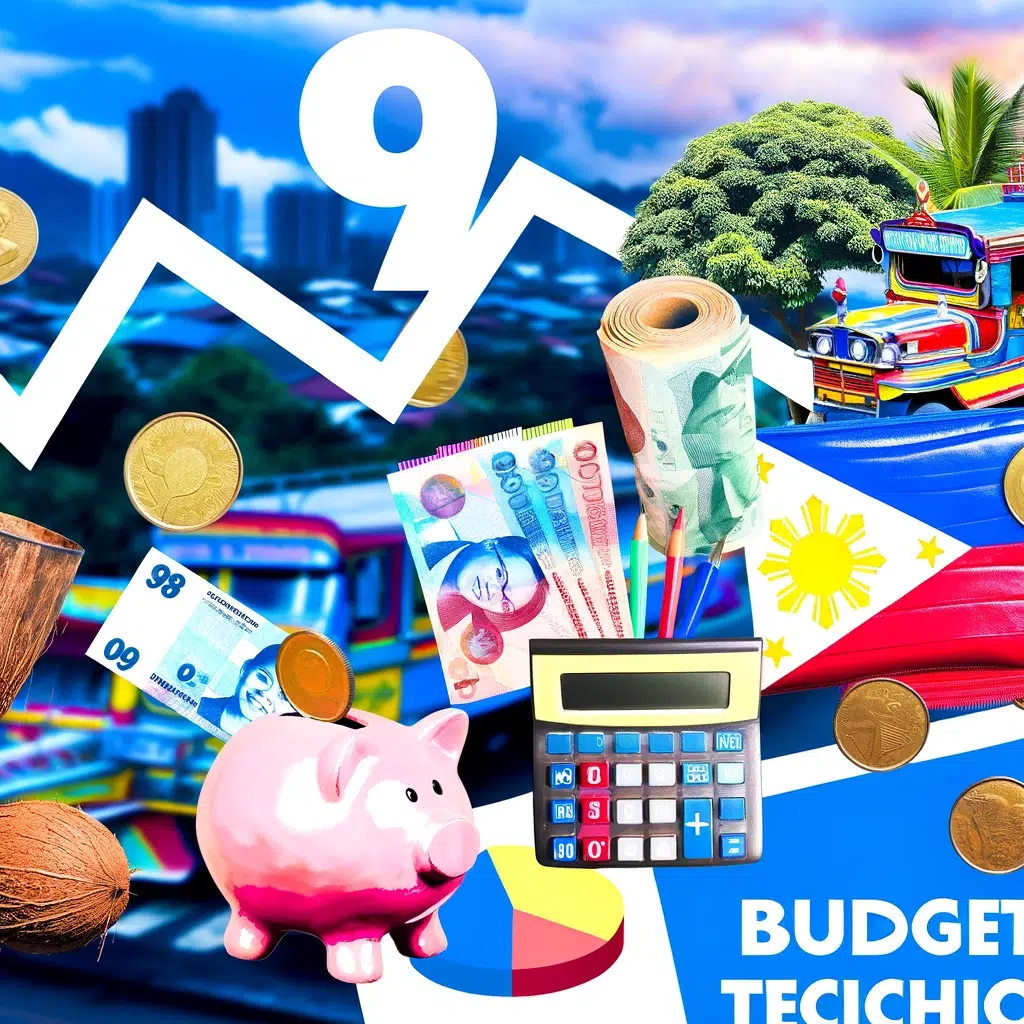Budgeting is crucial for financial stability and success, especially in the Philippines where economic conditions vary widely. It helps individuals manage their finances proactively, ensuring they can meet their needs and achieve their goals. In the Philippines, the economic landscape is marked by diverse income levels and a cost of living that fluctuates significantly between urban and rural areas. Filipinos often face unique financial challenges, such as handling remittances, coping with inflation, and preparing for natural disasters. Given these factors, adopting a budgeting method that suits the local economic context and personal financial objectives is vital.
Effective budgeting methods in the Philippines is not merely about expense tracking; it’s a strategic approach to navigating the complexities of the local economy and securing a financially stable future.
1. 50/30/20 Rule
The 50/30/20 rule is a budgeting framework that divides income into three categories:
- Necessities (50%): These are essential expenses required for daily living and working, such as:
- Housing (rent or mortgage)
- Food and groceries
- Transportation
- Healthcare
- Utilities (electricity, water, internet)
- Wants (30%): These are non-essential expenses that enhance lifestyle, including:
- Dining out
- Entertainment and leisure activities
- Shopping for non-essentials
- Hobbies and personal interests
- Savings/Debt Repayment (20%): This portion is allocated for financial growth and security, covering:
- Savings for emergencies and future goals
- Investment contributions
- Debt repayment, including credit cards and loans
Application in the Philippines
Adapting the 50/30/20 rule in the Philippines requires consideration of local economic factors and cultural practices:
Adjusting for Cost of Living:
- In areas with a high cost of living, such as Metro Manila, necessities might consume more than 50% of income.
- Adjustments might look like 60% for necessities, 20% for wants, and 20% for savings/debt repayment.
Cultural and Family Considerations:
- Budgeting for wants in the Philippines may also need to account for family support and social obligations, which are significant.
- Allocating funds for family gatherings, remittances to relatives, or community contributions is common.
Flexible Savings Approach:
- While maintaining savings is crucial, the exact percentage may be flexible based on income stability and other financial commitments.
- Prioritizing emergency funds and reducing debt are key goals within the savings category.
2. Envelope System
The envelope system is a budgeting method that involves using physical envelopes to manage and limit spending in different categories. Here’s how it works:
Allocation of Funds: Upon receiving income, cash is divided and placed into separate envelopes, each labeled for a specific spending category.
Categories: Common categories include groceries, dining out, entertainment, transportation, and utilities.
Spending Limit: The amount in each envelope represents the budget limit for that category for the set period (usually a month). Once the cash in an envelope is spent, no more spending is allowed in that category until the next budget cycle.
Application in the Philippines
Adapting the envelope system in the Philippines can be particularly effective due to the country’s cash-centric economy. Here’s how it can be tailored to fit common Filipino household expenses:
Essential Categories: Envelopes should be created for essential expenses that are common in Filipino households, such as:
- Groceries: Budgeting for market visits and supermarket shopping, considering the local cost of food items.
- Utilities: Allocating funds for electricity, water, internet, and mobile phone credits, which are crucial household expenses.
- Transportation: Setting aside money for daily commute costs, whether it’s for jeepneys, tricycles, buses, or fuel for personal vehicles.
Non-Essential Categories: Additional envelopes can be used for discretionary spending, such as:
- Entertainment and Leisure: Budgeting for outings, movie nights, or family gatherings.
- Personal Allowances: Money set aside for personal use, like salon visits, hobbies, or shopping.
Savings and Emergencies: While the envelope system primarily focuses on spending, it’s also wise to have an envelope for savings and emergency funds, reinforcing the habit of setting money aside for future needs and unexpected expenses.
Cultural Adaptation
In the Philippines, where family and community ties are strong, budgeting might also need to account for:
- Family Obligations: An envelope for family support, such as remittances to relatives in the provinces or contributions to family events.
- Social Contributions: Funds for community activities, church donations, or helping out neighbors in need, reflecting the Filipino value of “bayanihan” (community spirit).
Practical Considerations
Security: Handling cash requires careful consideration of security. It’s important to keep the envelopes in a safe place to avoid loss or theft.
Digital Adaptation: For those who prefer not to carry cash, a digital version of the envelope system can be implemented using separate bank accounts or budgeting apps designed to segregate funds into virtual “envelopes.”
3.Zero-Based Budgeting
Zero-based budgeting is a method where every peso of income is allocated to expenses, savings, or debt repayment, ensuring that total income minus total expenses equals zero. This approach requires meticulous planning and tracking of financial activities, as it involves:
Detailed Categorization: Listing all possible expenses, including fixed, variable, and unexpected costs.
Precise Allocation: Assigning specific amounts to each category, ensuring that the sum of all expenses matches the total income.
Regular Adjustment: Monitoring and adjusting the budget as needed to reflect actual spending and income changes.
Application in the Philippines
In the Philippine context, zero-based budgeting can be particularly effective due to the need to manage both regular and irregular expenses. Here’s how it can be adapted:
Regular Expenses: These include monthly bills such as utilities (electricity, water, internet), housing (rent or mortgage payments), transportation, and groceries. Allocating funds for these predictable costs is the first step in the zero-based budgeting process.
Irregular Expenses: Filipinos often face irregular expenses that need careful planning, such as:
- Fiestas and Celebrations: Many Filipino communities celebrate local fiestas and family events like birthdays and weddings, which can require significant spending.
- Seasonal Spending: Expenses can spike during certain times of the year, such as Christmas, New Year, and school enrollment periods. Budgeting for these seasonal costs is crucial.
- Emergency Funds: Setting aside money for unexpected expenses, like medical emergencies or home repairs, is an essential part of zero-based budgeting.
Cultural Considerations
- Extended Family Support: In the Philippines, it’s common to provide financial support to extended family members. This should be factored into the budget as a regular or irregular expense, depending on the situation.
- Community Obligations: Contributions to community events or helping neighbors in need can also be part of the budget, reflecting the Filipino value of communal support and solidarity.
Implementation Tips
- Detailed Tracking: Keeping a detailed record of all income and expenses is crucial for zero-based budgeting to work effectively. This can be done through budgeting apps, spreadsheets, or traditional pen and paper methods.
- Flexibility: While the goal is to allocate every peso, it’s important to remain flexible and adjust categories as real-life situations change, especially in response to unforeseen expenses or income fluctuations.
- Savings Goals: In zero-based budgeting, savings are treated as a necessary expense. Setting clear savings goals, such as building an emergency fund, saving for a home, or planning for retirement, can ensure that these objectives are prioritized in the budget.
4.The 60% Solution
The 60% Solution is a budgeting method where 60% of net income is allocated to committed expenses, which are essential and recurring monthly costs. The remaining 40% is then divided among retirement savings, short-term savings, and discretionary spending, often referred to as “fun money.” This method simplifies budgeting by creating a clear distinction between fixed expenses and flexible spending. Here’s how it breaks down:
Committed Expenses (60%): This category includes all necessary living expenses such as housing (rent or mortgage), utilities, groceries, transportation, insurance, and any other regular bills.
Retirement Savings: Part of the remaining 40% should go towards long-term savings, specifically for retirement, ensuring future financial security.
Short-term Savings: This includes savings for goals that are closer on the horizon, like an emergency fund, education, a vacation, or a major purchase.
Fun Money: The remaining portion is for discretionary spending on leisure activities, hobbies, dining out, or other personal indulgences.
Application in the Philippines
Adapting the 60% Solution in the Philippines may require adjusting the percentage allocated to committed expenses to better align with the Filipino lifestyle and financial obligations. Here’s how it can be tailored:
- Adjusting Committed Expenses: Given the varying cost of living across different regions in the Philippines, the portion for committed expenses might need to be higher or lower than 60%. For example, in urban areas where living costs are higher, more than 60% of income might be needed to cover essential expenses.
- Cultural and Family Considerations: Filipinos often have financial responsibilities that extend beyond their immediate household, such as supporting extended family or contributing to community funds. These cultural practices should be considered when allocating income to different categories.
- Flexible Savings and Fun Money: The division of the remaining 40% can also be adjusted based on personal priorities and financial goals. For instance, if retirement savings are a priority, a larger portion of the 40% could be allocated to that, with less left for short-term savings and fun money.
Practical Implementation
- Regular Review and Adjustment: Given the dynamic nature of personal finances and the economy, regularly reviewing and adjusting the budget is crucial. This ensures that the allocation remains relevant and effective in meeting financial goals.
- Use of Financial Tools: Employing budgeting apps or financial management software can help track spending against these categories and make adjustments as needed.
- Education and Planning: Understanding personal finance, including the importance of savings and investment, can help individuals make informed decisions about how to allocate their income effectively within the 60% Solution framework.
5.Pay Yourself First
“Pay Yourself First” is a financial strategy that emphasizes prioritizing savings and investments before addressing any other expenses. This approach encourages individuals to set aside a portion of their income for their future selves immediately upon receiving it, ensuring that savings and investment goals are met before daily spending begins. Here’s how it works:
Immediate Allocation: As soon as income is received, a predetermined amount or percentage is directed towards savings or investment accounts.
Savings Goals: This method helps in accumulating funds for long-term goals, such as retirement, buying a home, or funding education.
Financial Discipline: By saving first, individuals are less likely to spend all their income, fostering a habit of financial discipline and proactive financial planning.
Application in the Philippines
In the Philippine setting, applying the “Pay Yourself First” principle can be particularly effective given the various local savings and investment options available. Here’s how Filipinos can implement this strategy:
Automated Savings: Setting up automatic transfers from a checking account to a savings account can ensure that a portion of income is saved before it can be spent. Many Philippine banks offer automated savings plans that can help in executing this strategy effectively.
Investment in Government Programs: Filipinos can take advantage of local investment options like the Pag-IBIG Fund or the Social Security System (SSS). These government-backed programs offer savings and investment opportunities that provide financial security and growth. For example:
Pag-IBIG Fund: Apart from its primary offering of housing loans, Pag-IBIG also offers a savings program with competitive dividend rates, making it a viable option for long-term savings.
SSS: Investing in the SSS not only provides a safety net for retirement but also offers other benefits like loans, disability, and maternity benefits.
Retirement Planning: Filipinos can also invest in personal retirement accounts or insurance products that offer investment components, such as variable universal life insurance (VUL), to further secure their financial future.
Cultural and Economic Considerations
- Family and Social Obligations: In the Philippines, financial responsibilities often extend beyond personal needs to include family support and social contributions. The “Pay Yourself First” method can help ensure that individuals secure their financial future while still being able to fulfill these obligations.
- Income Fluctuations: For those with variable incomes, such as freelancers or business owners, the amount saved or invested may need to be adjusted periodically. However, the practice of prioritizing savings remains a constant goal.
Practical Tips
- Start Small: If saving a large amount initially is challenging, starting with a small percentage and gradually increasing it can make the transition easier.
- Monitor and Adjust: Regularly reviewing and adjusting savings goals and amounts is important to stay aligned with changing financial circumstances and objectives.
- Financial Education: Continuously learning about personal finance management and investment options can help Filipinos make informed decisions and maximize the benefits of the “Pay Yourself First” approach.
6.Cash-Only Diet
The Cash-Only Diet involves using physical cash for all transactions, eliminating the use of credit cards, debit cards, and electronic payments. This method helps individuals control spending and avoid debt by making the outflow of money more tangible and real. Here’s how it typically works:
Physical Currency: Withdraw a set amount of cash for a specific period (e.g., weekly or monthly) to cover all expenses, including bills, groceries, and discretionary spending.
Spending Limits: Once the cash is spent, no further spending is allowed until the next withdrawal period, enforcing strict budget discipline.
Debt Prevention: By using only cash, individuals are less likely to incur debt from credit card overuse or impulse buying.
Application in the Philippines
In the Philippines, where cash transactions are still prevalent, especially in local markets, small businesses, and rural areas, the Cash-Only Diet can be particularly effective. Here’s how it can be managed and its benefits:
Budget Allocation: Filipinos can divide their cash into categories such as food, transportation, utilities, and entertainment, similar to the envelope system, to ensure that all expenses are covered without exceeding the budget.
Cash Withdrawals: Regularly withdrawing a set amount of cash from the bank can help in sticking to the budget. Choosing safe and strategic times for withdrawals is important to ensure security and convenience.
Avoiding Debt: The immediate feedback of physically seeing cash decrease can deter impulse purchases and help avoid the accumulation of credit card debt, which often comes with high interest rates.
Benefits of a Cash-Only Diet in the Philippines
- Improved Spending Awareness: Handling cash can increase awareness of spending patterns and encourage more thoughtful purchasing decisions.
- Debt Reduction: By avoiding the use of credit, individuals can prevent debt accumulation and the associated interest and fees.
- Budget Discipline: The finite nature of cash enforces budget discipline, as spending is limited to the available amount.
- Cultural Compatibility: With many transactions in the Philippines still conducted in cash, especially in smaller towns and local markets, this method aligns well with the existing economic practices.
Challenges and Considerations
Security Concerns: Carrying large amounts of cash can pose security risks. It’s important to take precautions, such as not withdrawing more cash than needed and being discreet about cash handling.
Inconvenience: For some expenses, like online purchases or utility payments, using cash may be less convenient or not feasible. In these cases, individuals may need to find alternative payment methods, such as cash-based payment centers or prepaid cards.
Emergency Funds: It’s crucial to have some form of emergency savings, possibly in a bank account, to avoid the temptation of using cash set aside for daily expenses.
Adapting to Modern Needs
While the Cash-Only Diet has many benefits, it’s important to balance it with the practicalities of modern living. For example, maintaining a small bank account for necessary online transactions while using cash for daily expenses can provide a balanced approach.
7.The 30-Day Rule
The 30-Day Rule is a budgeting technique designed to curb impulse buying and encourage thoughtful spending. It involves waiting 30 days before purchasing a non-essential item. During this period, individuals can assess whether the item is a genuine need or a fleeting desire. Here’s how it works:
Reflection Period: When tempted to make a non-essential purchase, note the item and its cost, then wait 30 days.
Assessment: Over the month, consider the item’s importance and utility, evaluating if it’s truly needed or just a momentary want.
Decision Making: After 30 days, if the desire for the item persists and it fits within the budget, the purchase can be considered. Often, the urge to buy diminishes over time.
Application in the Philippines
In the Philippines, where shopping is a popular activity and online sales events frequently offer tempting deals, the 30-Day Rule can be particularly useful. Here’s how it can be adapted to the local context:
Sales and Promotions: With frequent online sales events on platforms like Lazada and Shopee, Filipinos are often enticed by discounts and special offers. The 30-Day Rule can help differentiate between genuine needs and impulse purchases driven by the allure of a sale.
Budget Alignment: Waiting 30 days allows individuals to assess whether the item fits within their budget, considering other financial commitments and priorities.
Cultural Considerations: Social and cultural factors, such as gift-giving during holidays and celebrations, can influence spending. The 30-Day Rule can help plan these expenses more effectively, avoiding last-minute financial strain.
Benefits of the 30-Day Rule in the Philippines
- Reduced Impulse Buying: This rule helps in curbing spontaneous purchases, leading to more deliberate and meaningful spending.
- Financial Planning: It allows time to evaluate the impact of potential purchases on one’s budget and financial goals, promoting better financial planning.
- Savings Enhancement: Money not spent impulsively can be redirected towards savings or investment, contributing to financial security and growth.
Challenges and Considerations
- Marketing Pressure: The constant bombardment of advertisements and sales promotions can make waiting 30 days challenging. Staying focused on long-term financial goals can help resist these temptations.
- Social Influences: Peer pressure and social media can encourage unnecessary spending. Being mindful of these influences and sticking to the 30-Day Rule can mitigate their impact.
Practical Tips
Tracking Wishlist: Keeping a list of desired items and their waiting period start dates can help manage and review deferred purchases systematically.
Financial Goals Alignment: Regularly reviewing financial goals and priorities can reinforce the rationale behind delaying purchases and ensure alignment with broader financial objectives.
8.The Priority-Based Budget
The Priority-Based Budget involves organizing spending categories by their level of importance and allocating funds based on this hierarchy. This method ensures that the most critical expenses are covered first, aligning financial resources with personal values and needs. Here’s how it works:
Identify Priorities: List all spending categories, then rank them in order of importance, from essential to least essential.
Allocate Funds: Distribute income across these categories, starting with the most important, ensuring these are fully funded before moving to less critical areas.
Adjust as Needed: Regularly review and adjust the budget to reflect changes in income, expenses, or priorities.
Application in the Philippines
In the Philippines, where family, education, and healthcare are often top priorities, a Priority-Based Budget can be particularly effective. Here’s how it can be tailored to Filipino financial priorities:
Education: Given the high value placed on education in Filipino culture, allocating funds for tuition, school supplies, and other educational expenses is often a top priority.
Healthcare: With varying access to public healthcare services, setting aside money for medical emergencies, regular check-ups, and health insurance is crucial.
Family Support: Many Filipinos have financial responsibilities not only to their immediate family but also to extended family members, necessitating a budget allocation for familial support, including regular remittances.
Housing and Utilities: Ensuring that housing costs, utilities, and other essential living expenses are covered is a fundamental aspect of the budget.
Savings and Investments: Prioritizing savings for emergencies, future goals, and investments is also a key component of a Priority-Based Budget in the Philippines.
Benefits of Priority-Based Budgeting in the Philippines
- Aligned Spending: This budgeting method ensures that spending aligns with personal and cultural values, leading to greater financial satisfaction and security.
- Financial Control: By focusing on priorities, individuals can better control their finances, ensuring that essential needs are met before spending on less critical items.
- Adaptability: The budget can be quickly adjusted to accommodate changes in financial circumstances or priorities, providing flexibility and resilience.
Challenges and Considerations
- Balancing Needs and Wants: Distinguishing between essential needs and discretionary wants can be challenging, especially with societal and familial pressures.
- Dynamic Priorities: Priorities can change over time due to life events, economic conditions, or personal growth, requiring ongoing budget adjustments.
Practical Tips
Regular Reviews: Conducting regular budget reviews can help ensure that spending remains aligned with current priorities and financial goals.
Emergency Fund: Maintaining an emergency fund as a top priority can provide a financial buffer and reduce stress in unexpected situations.
9. The Apps and Tools Budget
The Apps and Tools Budget method involves leveraging technology to track spending and manage finances efficiently. Budgeting apps and financial tools offer various features like expense tracking, budget creation, financial goal setting, and reporting. These tools can automate much of the budgeting process, making it easier to stay on top of financial matters. Here’s how they work:
Expense Tracking: Users can input or sync their purchases and expenses to monitor where their money goes.
Budget Creation: These tools allow users to set up customized budget categories and allocate funds accordingly.
Goal Setting: Many apps provide features to set and track financial goals, such as saving for a vacation, buying a home, or funding education.
Reporting and Analysis: Users can access reports and analyses of their spending habits, helping to identify areas for improvement.
Application in the Philippines
In the Philippines, where smartphone and internet usage is widespread, budgeting apps and tools can be particularly effective for managing personal finances. Here’s a look at how these tools can be utilized:
Popular Budgeting Apps: Apps like GCash, PayMaya, and Coins.ph are widely used in the Philippines for transactions and budget management. These apps offer features like expense tracking, bill payments, and savings accounts, making them suitable for a comprehensive budgeting approach.
Local Currency and Context: Many budgeting apps now support transactions in Philippine Pesos (PHP) and are tailored to the local financial context, offering features like tracking remittances, local bill payments, and even investments.
Integration with Financial Institutions: Some apps integrate directly with Philippine banks and financial services, providing a seamless way to manage finances, track spending, and make payments all in one place.
Benefits of Using Apps and Tools for Budgeting in the Philippines
- Convenience: Digital tools offer the convenience of managing finances anytime and anywhere, which is particularly beneficial in the fast-paced lifestyle of urban areas.
- Real-Time Tracking: With instant updates and notifications, users can monitor their spending in real-time, helping to avoid overspending and manage their budget more effectively.
- Financial Insights: These tools often provide valuable insights into spending patterns and financial health, aiding in better financial decision-making.
Challenges and Considerations
- Digital Literacy: Users need a certain level of digital literacy to effectively use these apps and tools, which may be a barrier for some individuals.
- Privacy and Security: Ensuring the security of financial data is crucial. Users should choose apps with strong security measures and be mindful of their data privacy.
Practical Tips
Choose the Right App: Select an app that fits your financial needs and lifestyle. Consider features, user interface, security, and reviews.
Regular Use and Review: Regularly update and review your financial information in the app to keep your budget accurate and effective.
Combine with Other Methods: Consider using these apps and tools in conjunction with other budgeting methods, like the envelope system or zero-based budgeting, for a more comprehensive approach.
Conclusion
In conclusion, employing a variety of budgeting methods can significantly enhance financial management in the Philippines, catering to the unique economic landscape and cultural nuances of Filipino life. Whether it’s the disciplined approach of the 50/30/20 rule, the tangible cash management of the envelope system, the meticulous planning of zero-based budgeting, the strategic allocation of the 60% Solution, the forward-thinking of Pay Yourself First, the practical restraint of the Cash-Only Diet, the reflective pause of the 30-Day Rule, the value-driven focus of the Priority-Based Budget, or the technological assistance of budgeting apps and tools, each method offers a pathway to achieving financial stability and success. By understanding and applying these budgeting strategies, Filipinos can navigate their financial journey with confidence, making informed decisions that align with their personal and cultural priorities, ultimately leading to a more secure and prosperous financial future.
Recommended: The 2024 Guide to Growing Your Savings: Smart Tips for Financial Success














Leave a Reply